Introduction
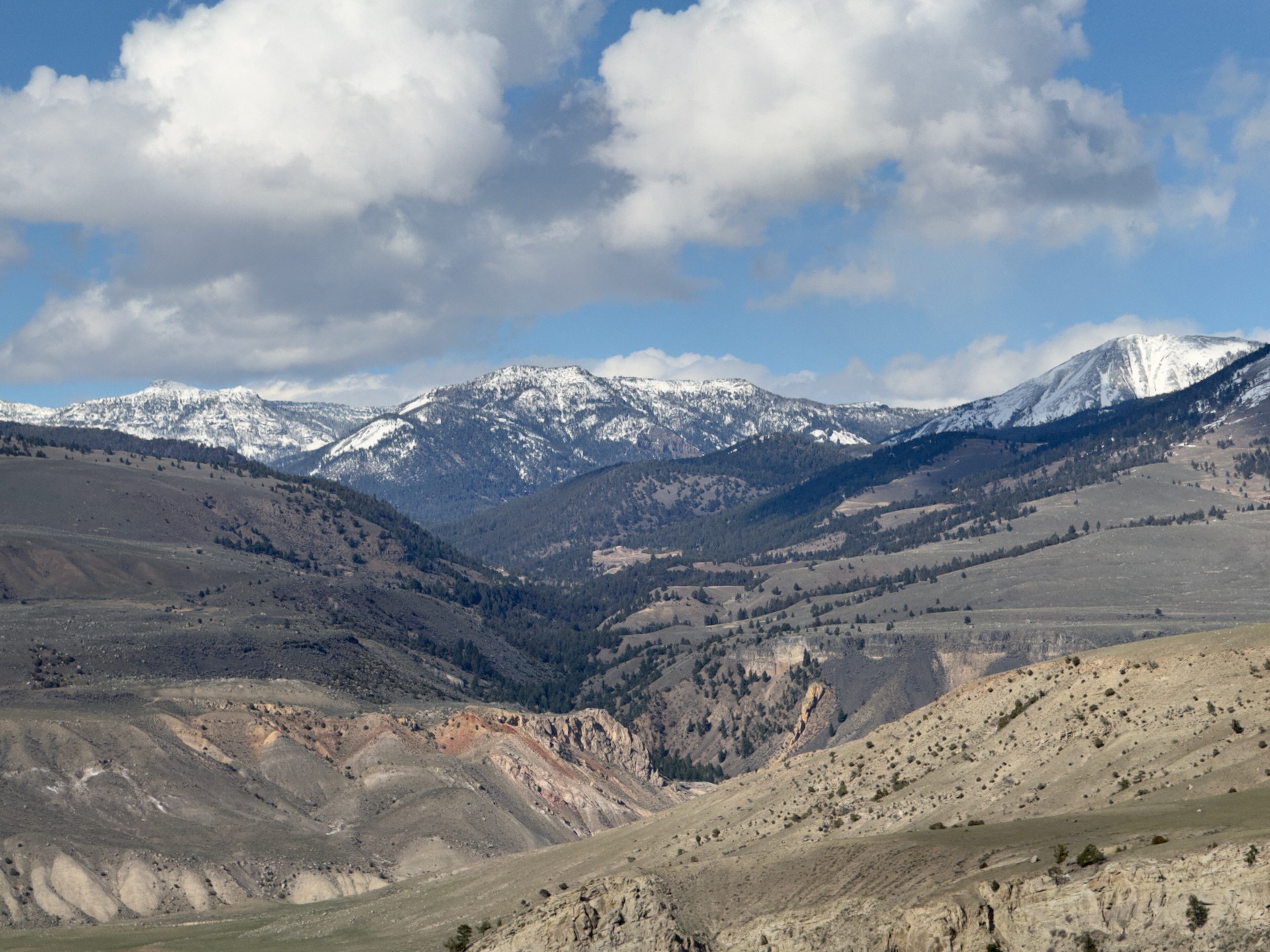
In April this year, my wife Hideko and I embarked on a month-long road trip from our home in Eugene, Oregon, to two of our National Parks: Yellowstone and Grand Teton. We have visited these two parks as often as possible since 2006, and the experience of each visit is unique.
We chose April this year to avoid crowds in the Parks and wildfire smoke, knowing that snow would keep many of the Yellowstone and Grand Teton roads and sites closed.1
When we visited in May 2023 wildfires in northern Alberta, Canada created massive clouds of brown smoke that wafted south to Yellowstone fouling the air and obscuring the mountain views.2
The photo above is from the road between Gardiner, Montana (one mile from the north entrance to Yellowstone) and Mammoth (the park headquarters), about one thousand feet above Gardiner.3
Yellowstone
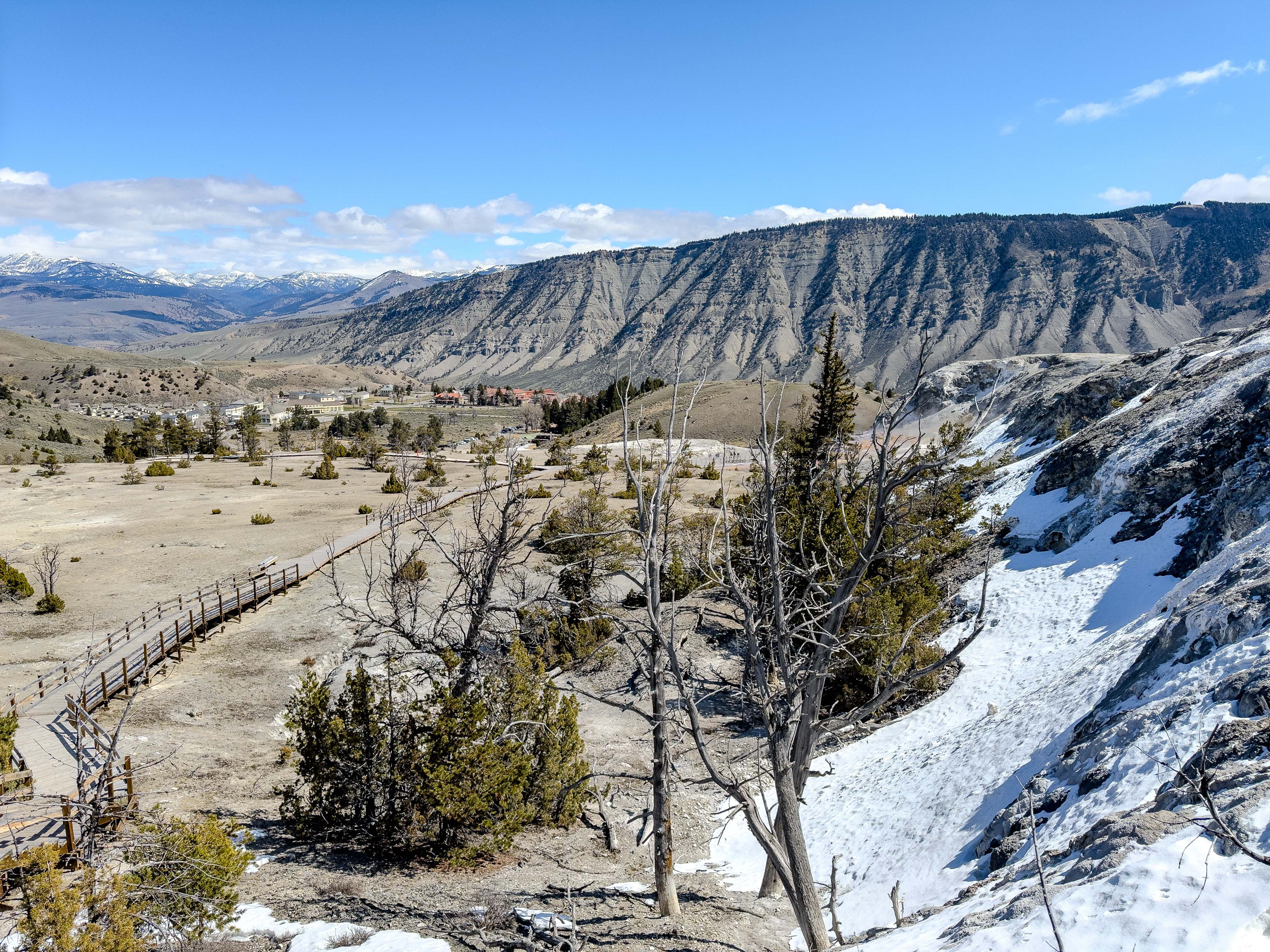
This Yellowstone visit got off to a memorable start when we took an expired can of bear spray into the Albright Visitor Center in Mammoth. The ranger on duty at the reception desk who greeted us spoke in a distinctive, slow Southern drawl, and as I handed him the can, he joked that an old can of bear spray “only protects your big toe.” I noticed his name tag said “Bach” and I realized he was Orville “Butch” Bach, a longtime ranger who has published a delightful two-volume memoir of his many years as a seasonal ranger, mostly in Yellowstone.4 I greatly enjoyed reading both books and was thrilled to have met him in Yellowstone.5
The photo above shows the boardwalk at Mammoth Hot Springs, and in the distance is the cluster of buildings including the Albright Visitor Center where we met ranger Orville “Butch” Bach.
Blacktail Lakes
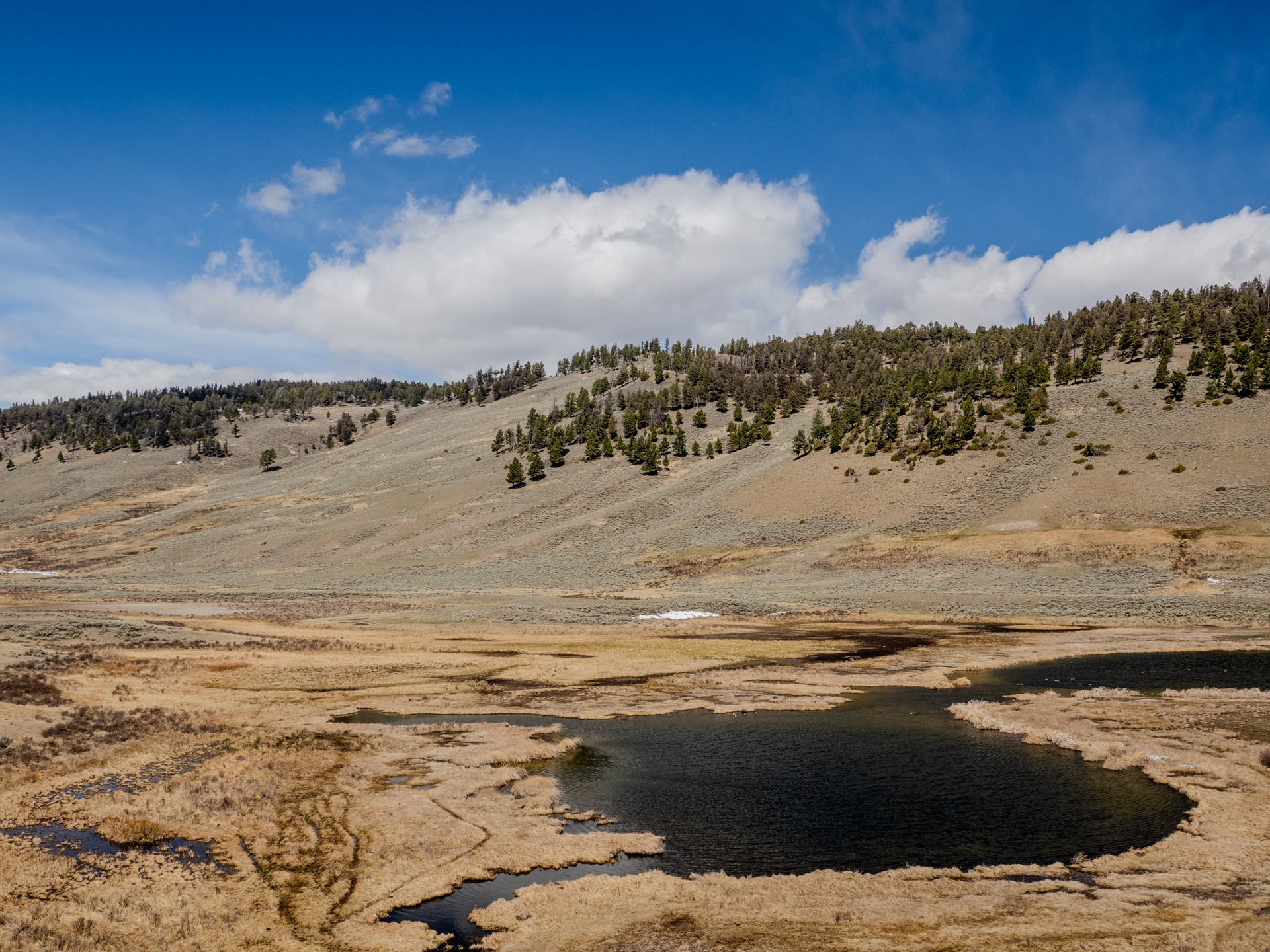
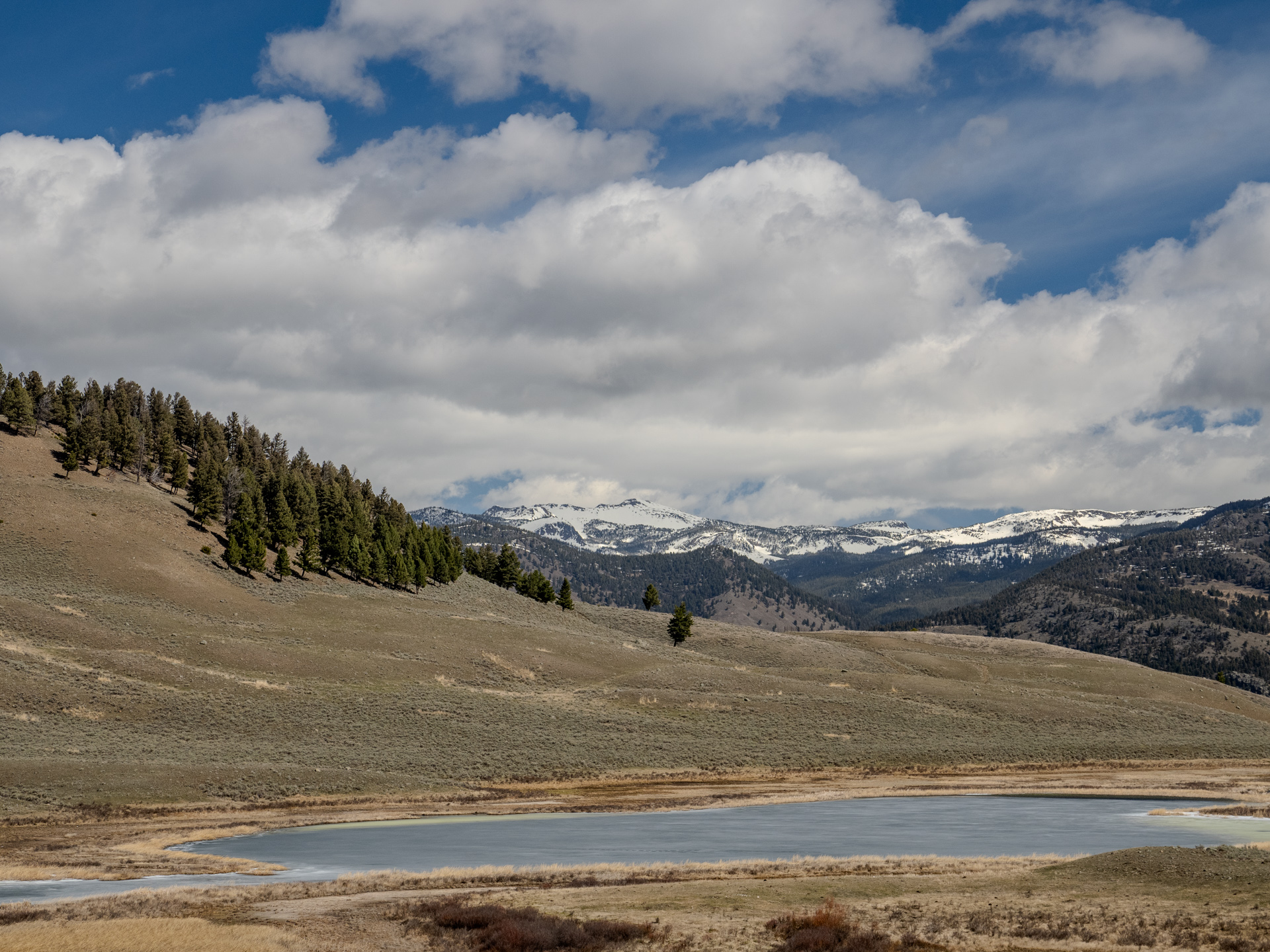
One of the first places we always stop as we enter the Park from the north entrance is Blacktail Lakes on the north side of the road between Mammoth and Tower Junction. The lakes flow into Blacktail Deer Creek, and then into the Yellowstone River.
Standing at the overlook listening to the wind and looking for wildlife for a few moments gives a sense of the quiet of this natural place. In the spring, it is often possible to hear the thrilling duet of a pair of Sandhill Cranes.
On this trip, two pairs of Sandhill Cranes strolled in their distinctive manner along a low mound near the lakes.

Lamar River
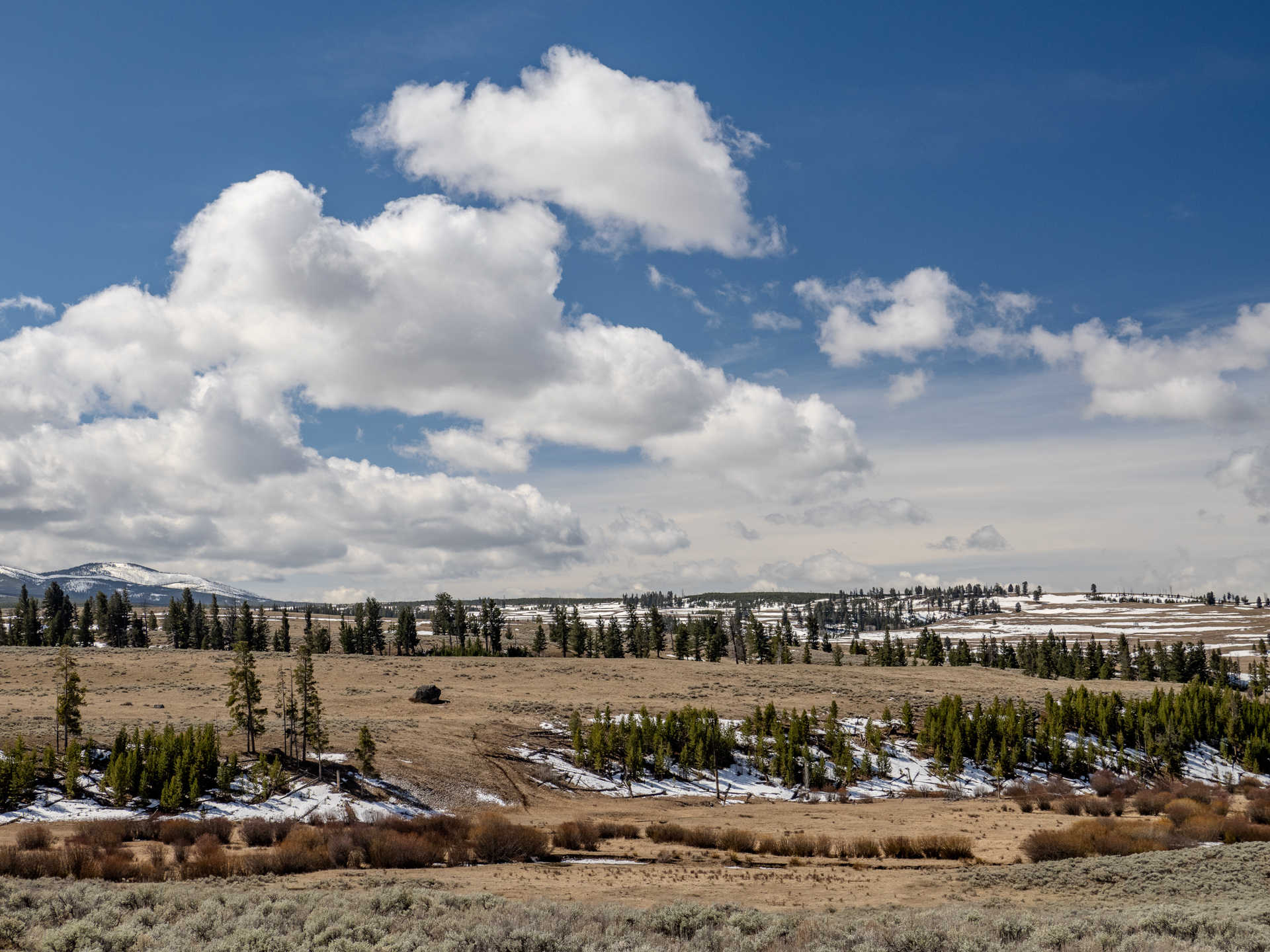
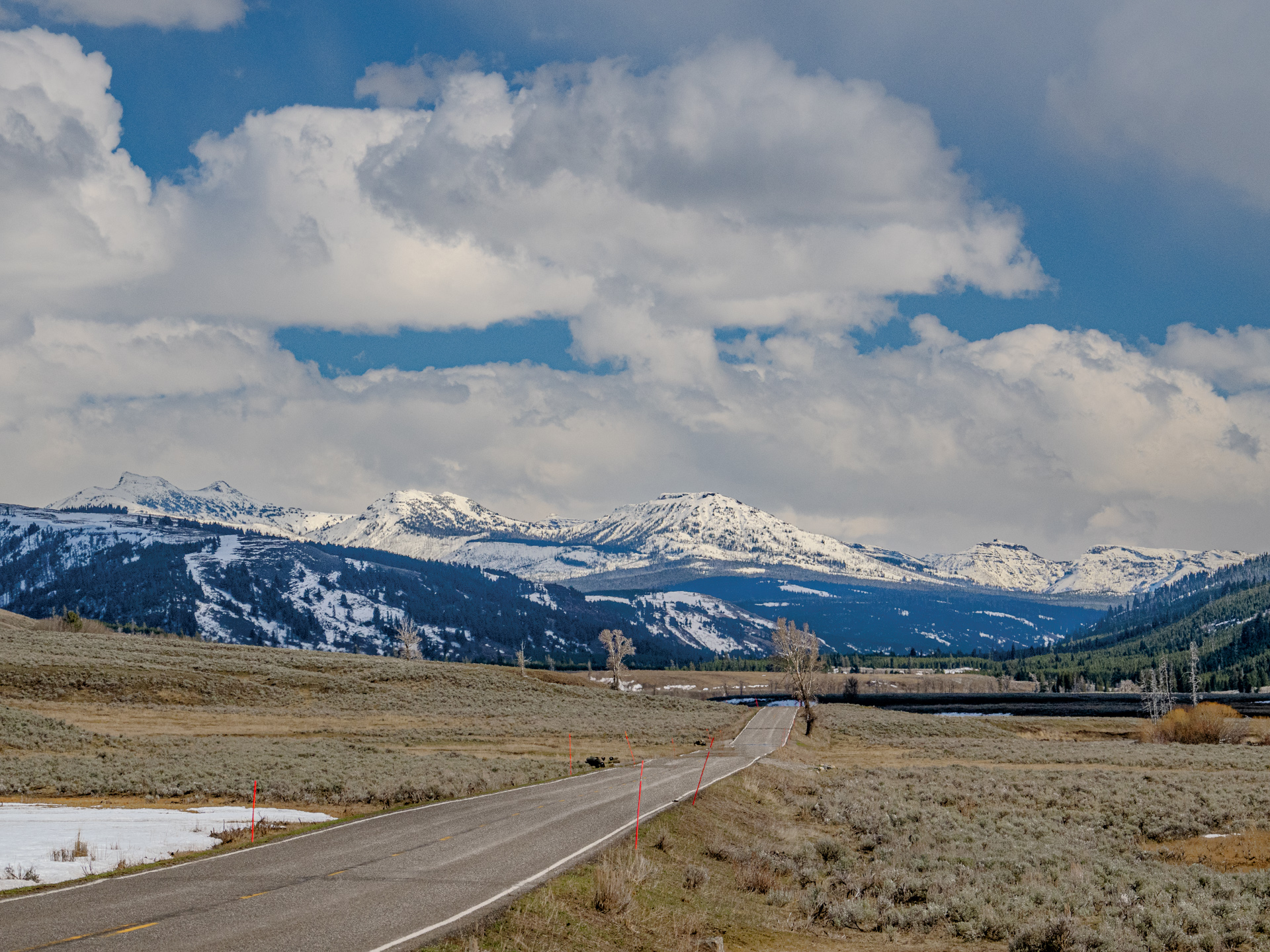
The Lamar River is a highlight of visits to the north side of Yellowstone.
The Lamar River is a tributary of the Yellowstone River, approximately 40 miles (64 km) long, in northwestern Wyoming in the United States. The river is located entirely within Yellowstone National Park.6
There are several pullouts with commanding views of the terraced uplands on the south side of the road which give an awe-inspiring sense of spaciousness and wilderness.
We visited Yellowstone and the Lamar Valley for the first time in March 2006 when snow still dominated the scene, and returned in the winter of 2007/8 and photographed a black wolf as it played on the frozen banks of Soda Butte Creek (near the confluence with the Lamar River), one of my fondest memories from Lamar Valley.
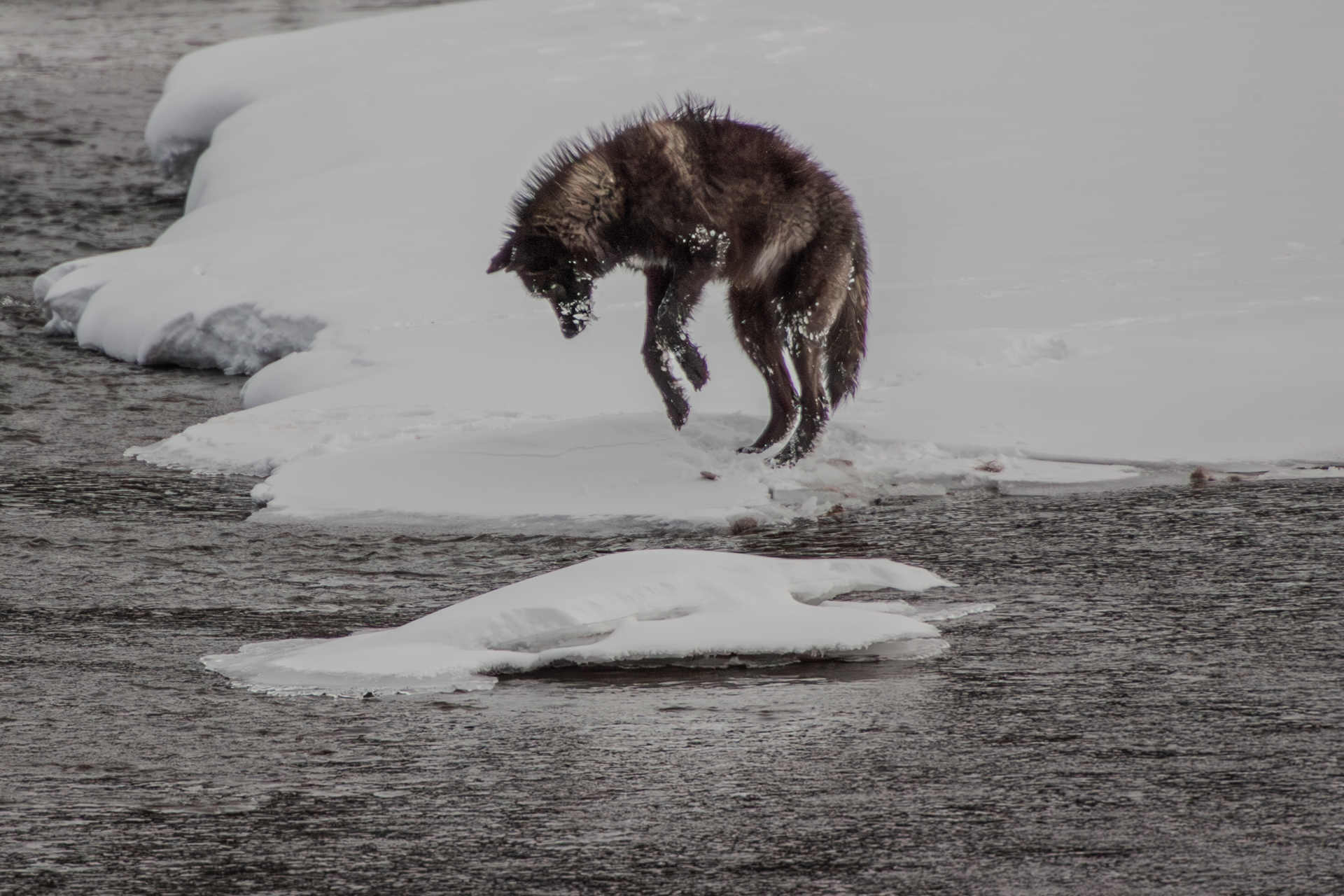
The view from the road to the north side of the Lamar Valley is closer to the hills, and our most memorable sights have been wolves chasing elk over the ridges and occasional grizzly bear sightings. We have often enjoyed seeing bison here, as in the photo farther below.

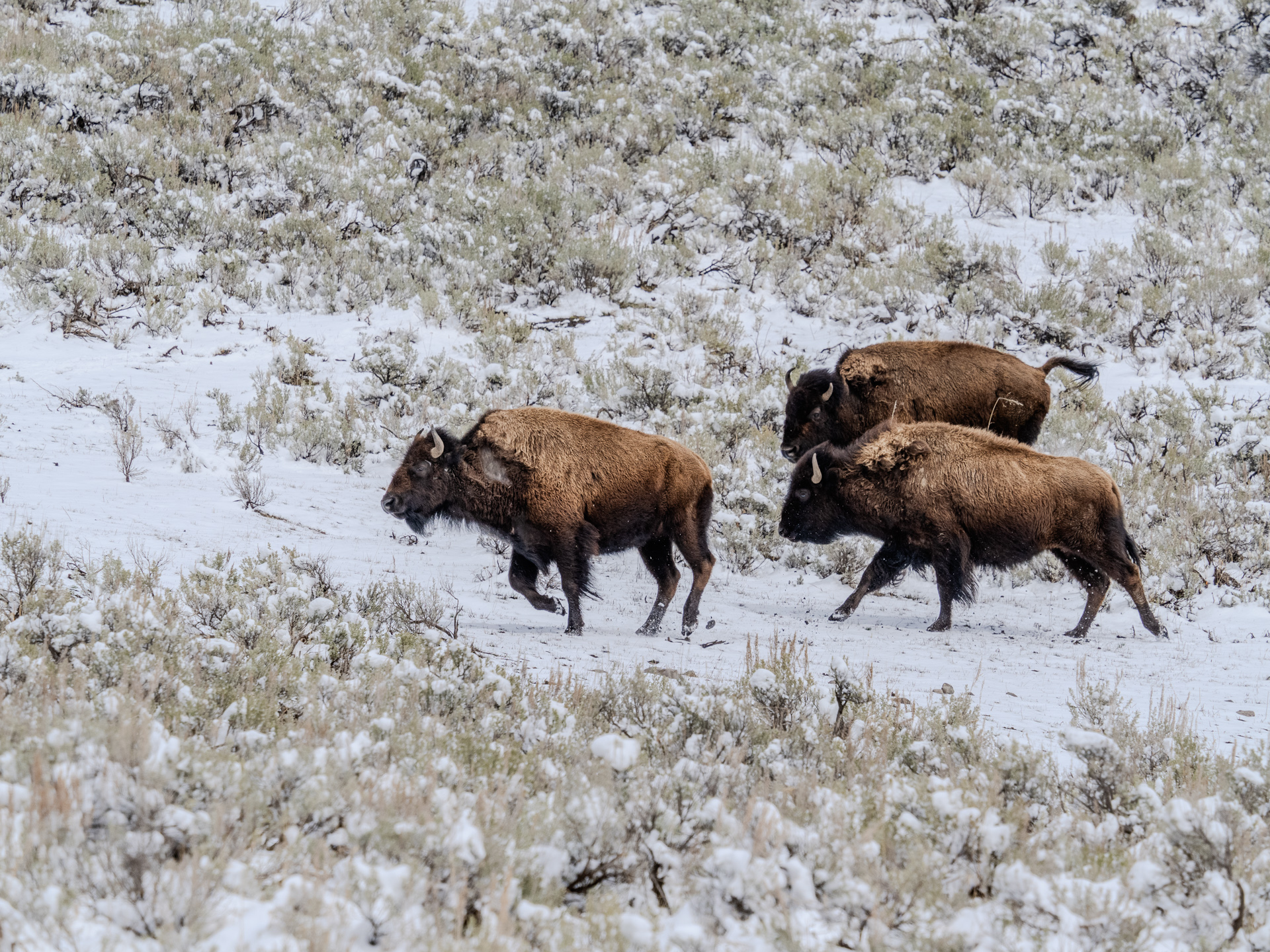
Snow can occur even in mid-April, as happened during our visit this year.
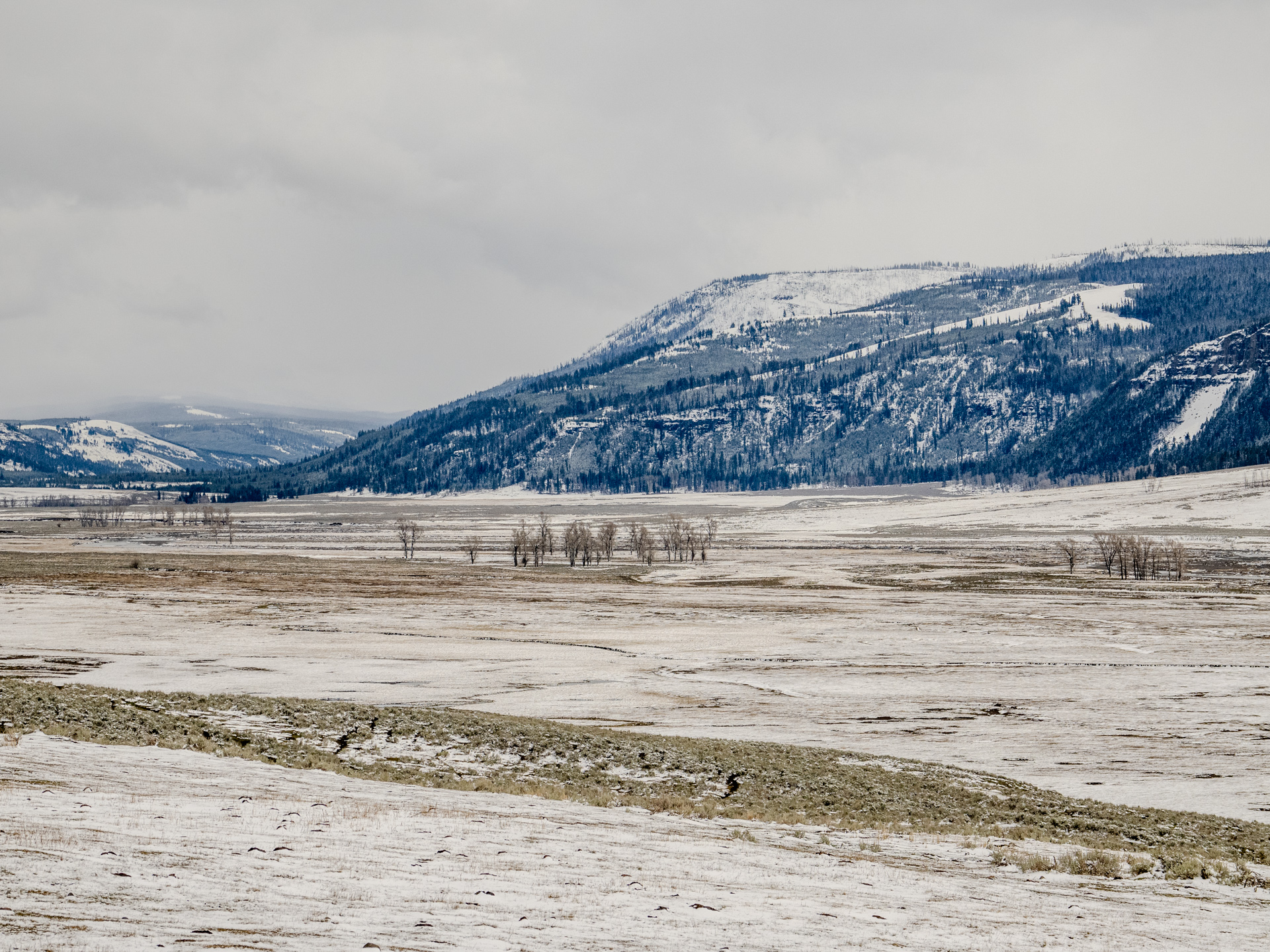
This view also gives an idea of the dimensions of the Lamar Valley, which the US Geological Survey describes as “flat bottomed and about 1.5 km wide for 10 km upstream from Lamar Canyon.”7
Lamar Canyon
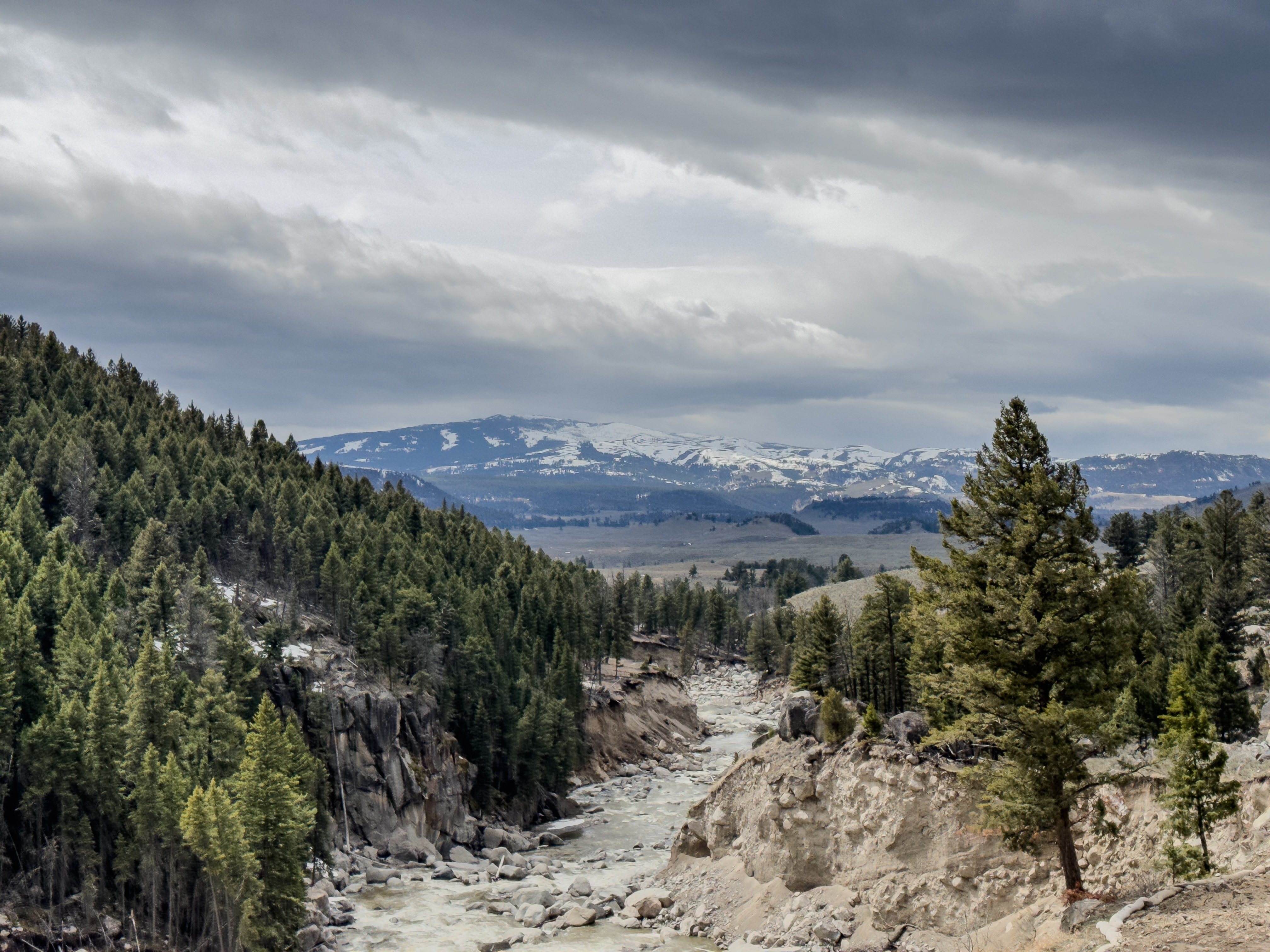
Downstream from the broad Lamar Valley, the River flows through a narrow canyon with walls of “…2.7-billion-year-old, light-pink gneiss.”8
This canyon is home to an Osprey nest atop a tall snag, precariously rooted above the Lamar River. We often stopped at this location during spring visits to watch the Osprey pair in the nest. In June 2022, a devastating flood swept through the Lamar, Gardiner, and Yellowstone rivers, eroding the banks, roads, and some houses, and isolating the town of Gardiner. Damage to the stream banks in Lamar Canyon is visible in the photo above.
Flooding also happened here in the ice age as described in the quotation below from the National Park Service website.
During glacial retreat, water flowed differently over Hayden Valley and deposited various sediments. Glacial dams also backed up water over Lamar Valley; when the dams lifted, catastrophic floods helped to form the modern landscape around the North Entrance of the park.9
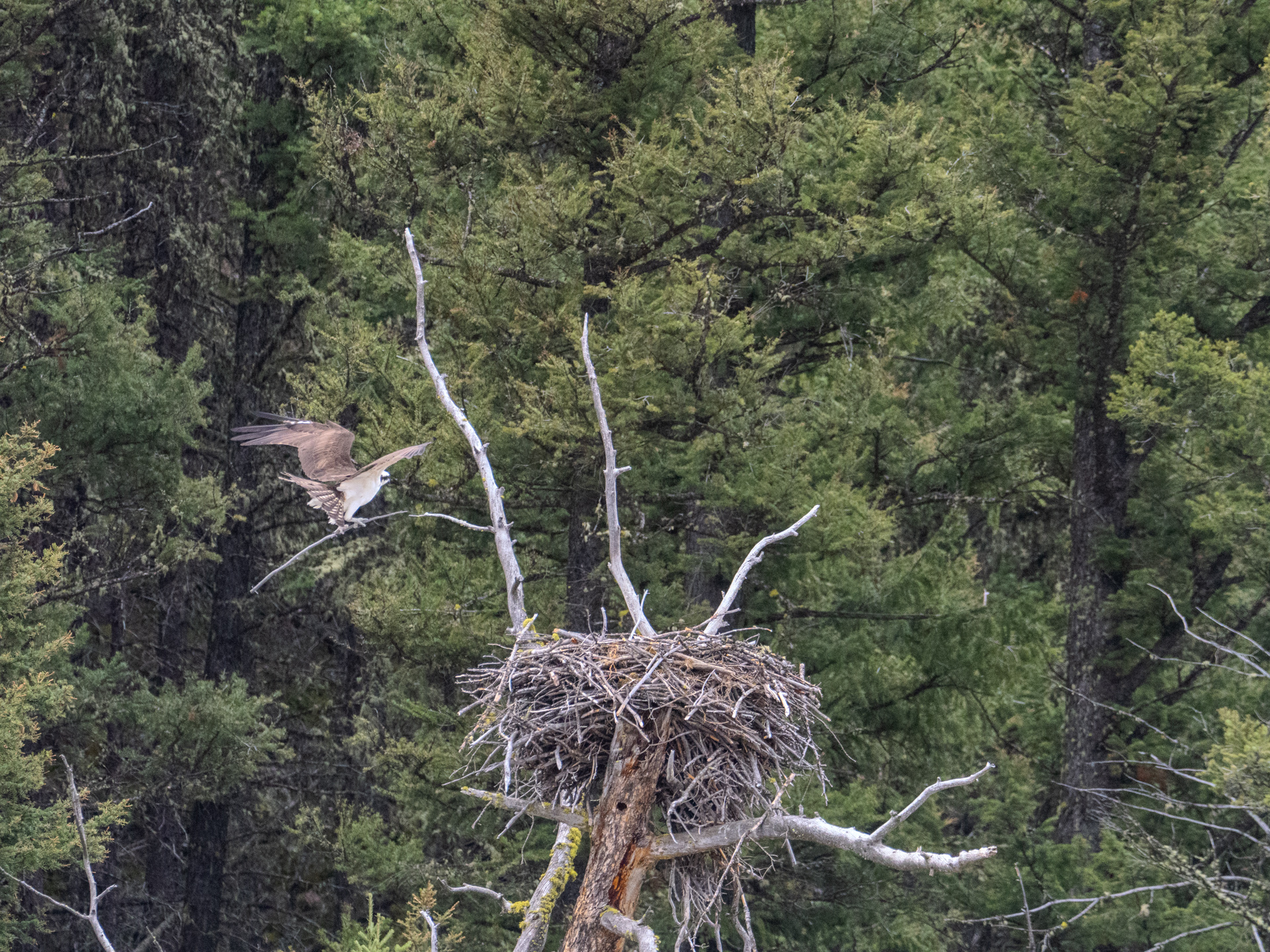
The pullout opposite this nest was closed in 2023 due to road work undertaken by the Park Service to repair the flood damage. Thankfully, the work is complete, and the pullout is now expanded, allowing for easier access.
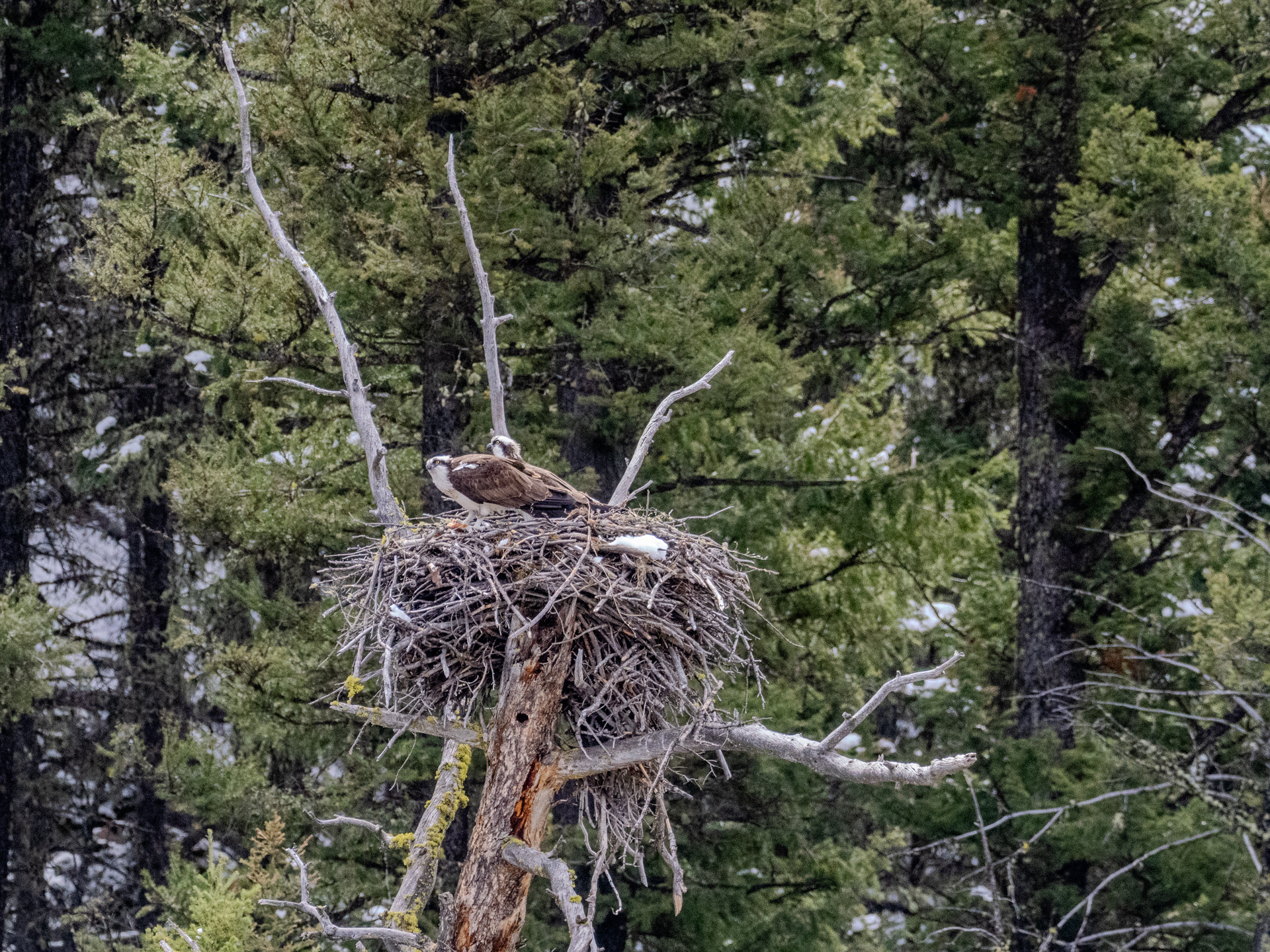
Only about thirty nesting pairs of Osprey are currently in Yellowstone, less than one-third of the number at its recent peak in 1994.
The recent history of Yellowstone’s bald eagles and osprey is closely tied to the fate of the Yellowstone cutthroat trout, and equally to the invasion of the non-native lake trout. Lake trout are a large and long-lived, piscivorous species of freshwater char that are native to lakes of northern North America but are invasive in many lakes in the western contiguous United States.10
Gardiner to Jackson

After five quiet days of walks at Mammoth Hot Springs and slow drives on the Mammoth to the northeast entrance road contemplating and photographing the wide vistas, it was time to leave.
The road from Mammoth to West Yellowstone opened in the Park on April 19, and on the 20th, we drove from Gardiner to West Yellowstone. Along the way, we stopped at Norris Geyser Basin and walked the extensive board walks, fascinated by the range of colors.
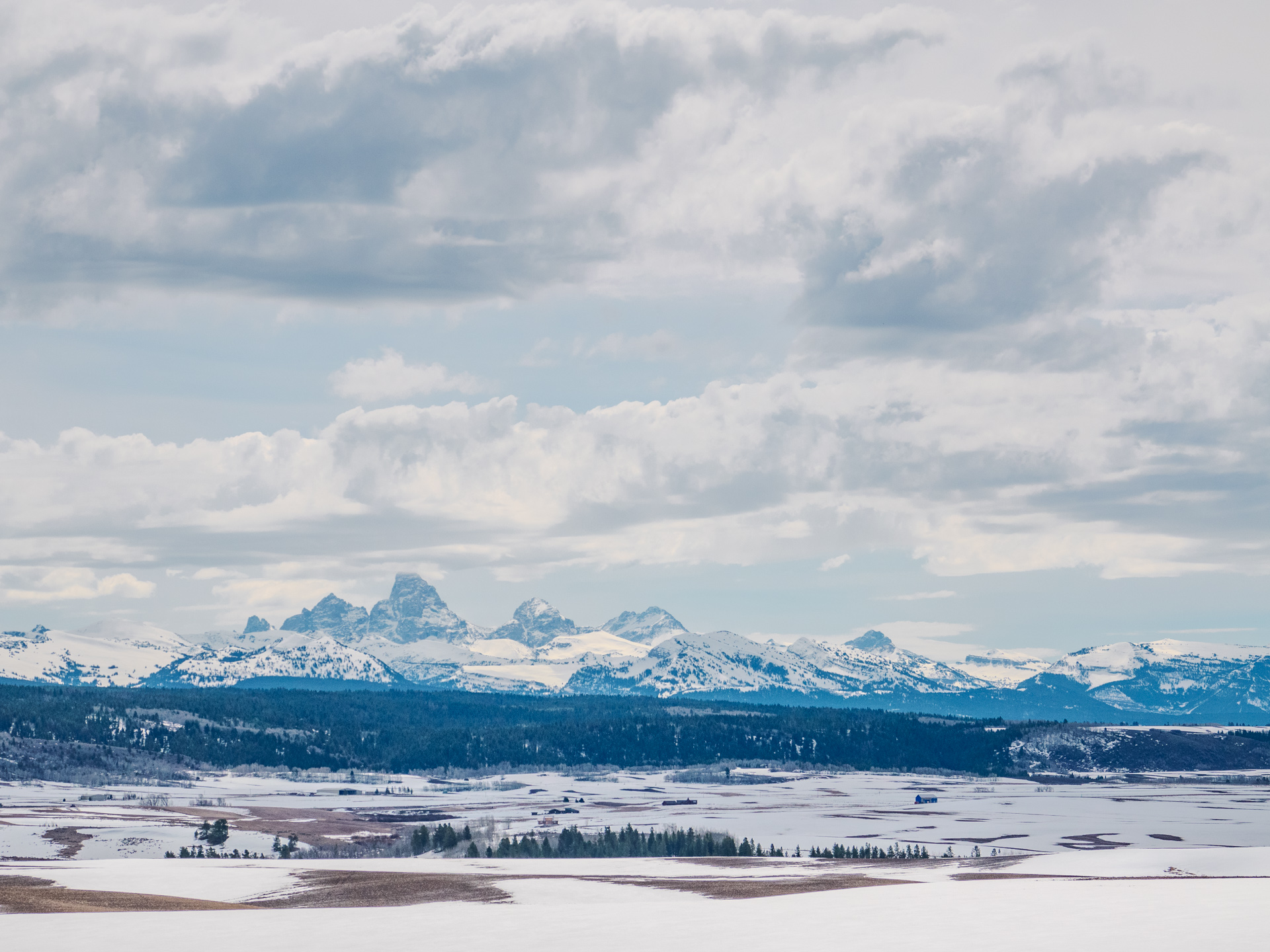
On the 21st, we went through Idaho and stopped near Ashton to photograph the above view of the Teton Range from the west. This is a perspective that is not often shown.
Grand Teton

We drove over the Teton Pass, descending the 10% grades into Jackson, a small city in the wealthiest county in America.11
On a drive to the Moran Junction entrance to Grand Teton National Park I noticed the silhouette of a familiar shorebird in a field. I stopped and photographed a Long-billed Curlew (Numinous americanus) foraging on the edge of remnant snow. We have also photographed these large shorebirds in Malheur National Wildlife Refuge in eastern Oregon; the Greater Yellowstone area is well within their range.
Pacific Creek

I had a rather different interaction with a ranger at the entrance to Grand Teton National Park near Moran Junction.
I asked the ranger if Pacific Creek/Two Ocean Lake Road was open, and got a blank stare in response followed by “I don’t know where it is”; I mentioned it was just up the road from the entrance booth. The ranger consulted a map and joked that I would have to let her know if it was open on my way back.” Clearly, this ranger was new to the Park.
We drove on Pacific Creek Road a few mornings looking for wildlife (it was open, but I didn’t get a chance to brief the ranger), and we found beautiful scenery and quiet soundscapes of birdsong and wind.
The source of Pacific Creek is Two Ocean Creek, which is in the marshes of Two Ocean Pass on the continental divide, at a place known as “Parting of the Waters.” From that spot, Atlantic Creek flows to the Yellowstone River, which eventually empties into the Gulf of Mexico. Pacific Creek flows to the Snake River, which ends up in the Pacific Ocean, off the Oregon and Washington coasts. 12

The photo above shows a small creek flowing from one of the two lakes that feeds Pacific Creek shortly before it joins the Snake River.
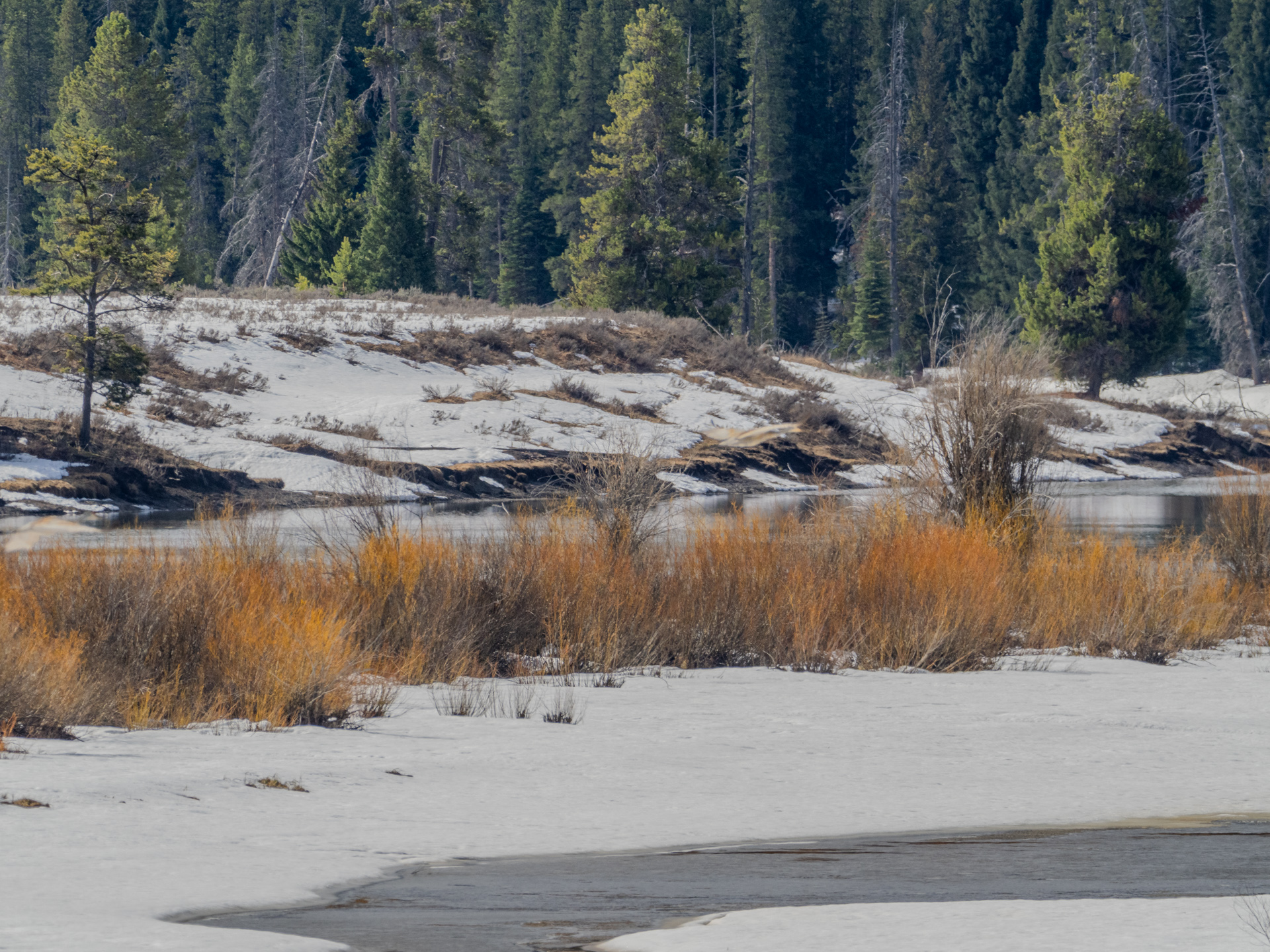
While standing outside listening to birdsong and taking in the views surrounding Pacific Creek, a guy drove up and asked what I was seeing. I told him I had seen a Northern Harrier, and he asked if I was “into birds.” I said yes, and he mentioned Great Great Owls in the area; he also said he lives nearby. I told him, “You are a very lucky man.” As he drove away, I noticed the Oregon license plate on his pickup truck —a fellow Oregonian.
Oxbow Bend

Oxbow Bend is a short distance upstream on the Snake River from the confluence of Pacific Creek, a well-known wildlife and landscape photography hotspot.
The prominent mountain on the right side of the photo above is Mt Moran (12,610 ft/3,843 m). The remaining snow along the river reduced significantly during the few days of our visit.
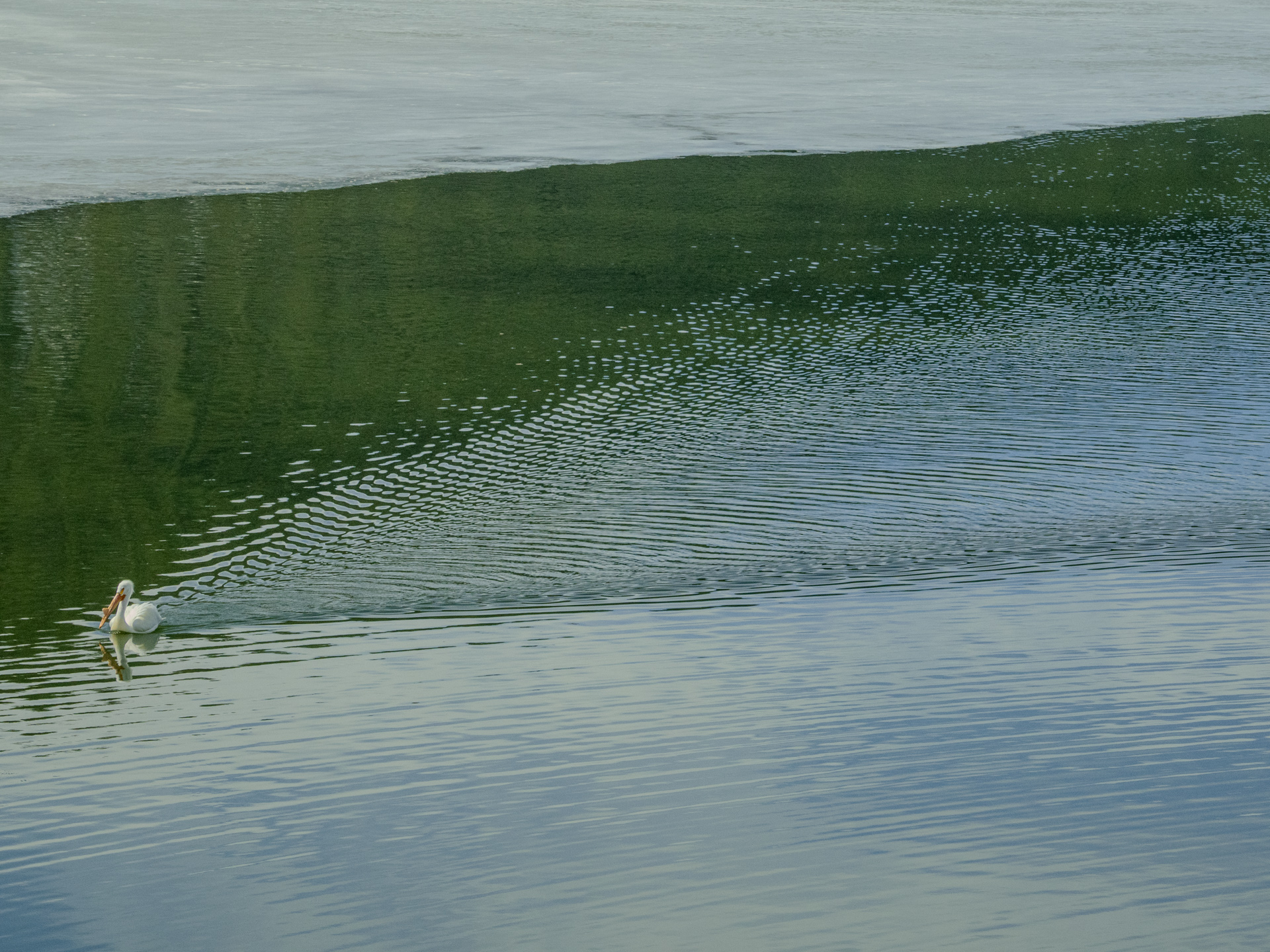
Most days, we were treated to White Pelicans at Oxbow Bend, including the individual above, leaving a gentle wake that divided the still water into patches of green and blue.
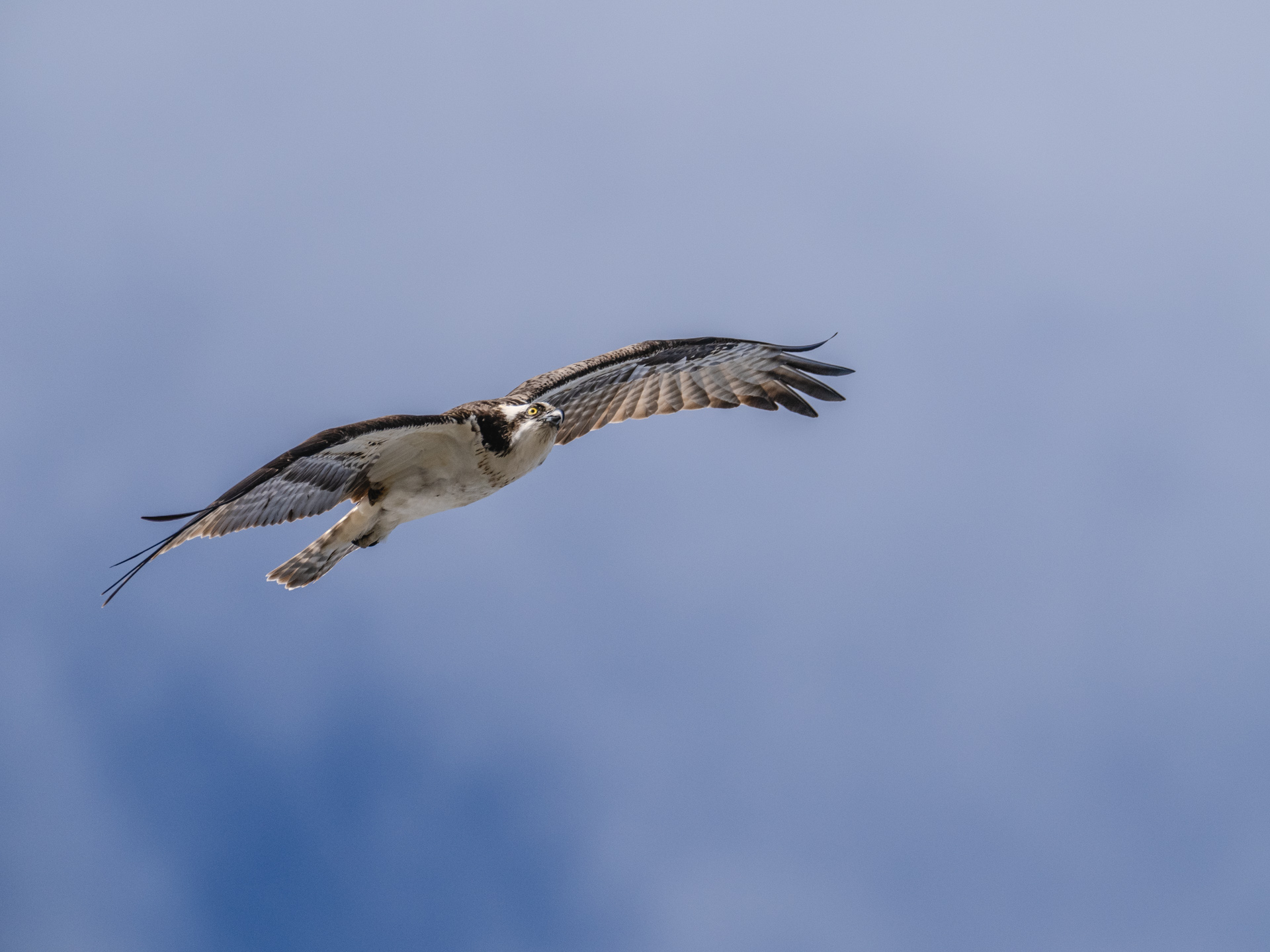
I was delighted to see an Osprey overhead at Oxbow Bend, looking for fish. We didn’t find the nest, but having seen Ospreys before here, it is certain there is one nearby.
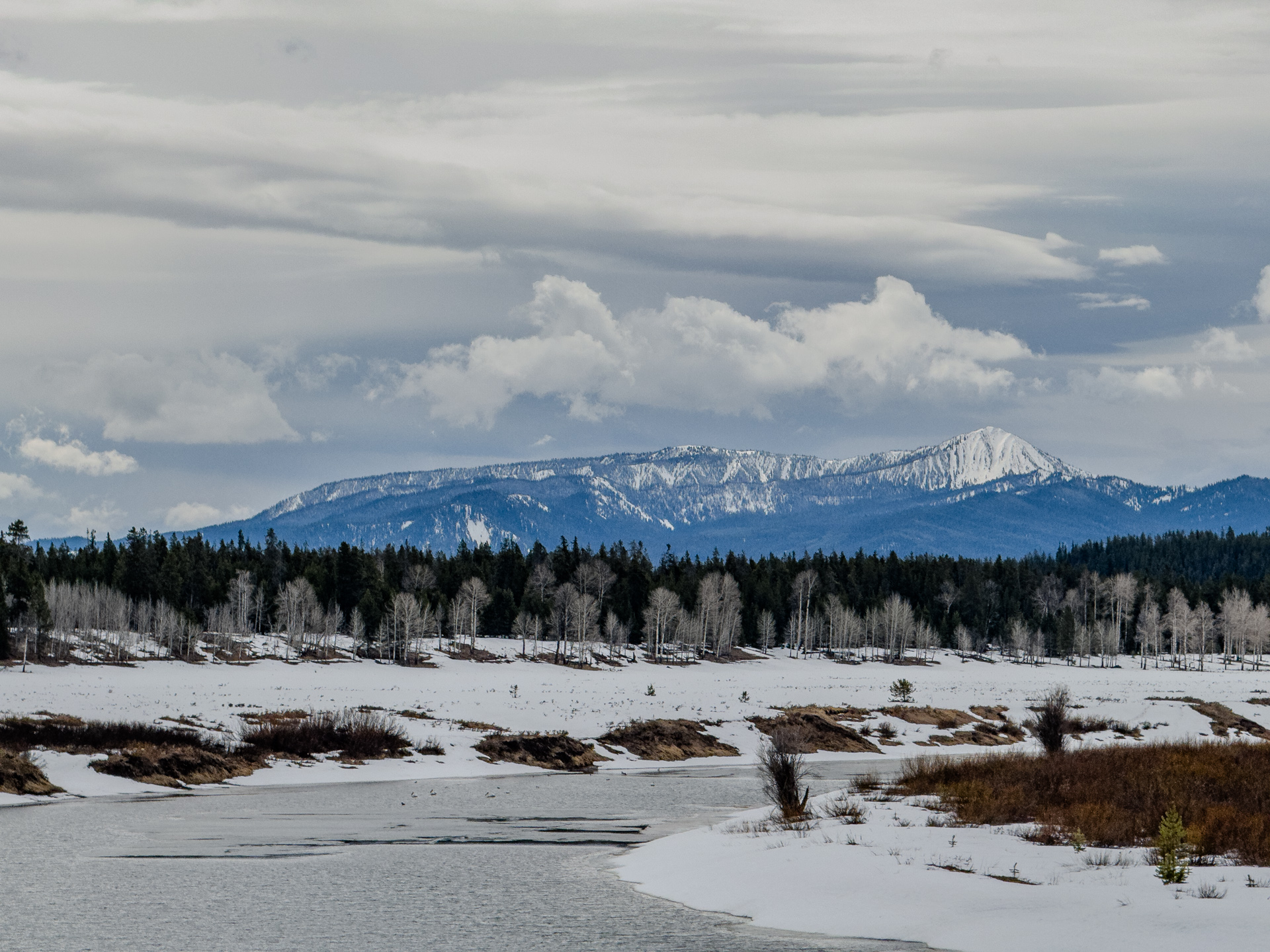
The landscape to the south of Oxbow Bend is more distant than the view to the west, but on an overcast day, it is inspirational.

My fondest memory of Grand Teton National Park is from our visit in May 2018. We spotted a grizzly bear with two year-old cubs walking down a bank covered in snow near Jackson Dam. That was the best photo opportunity I have had with a grizzly bear, and we were at a safe distance on the opposite side of the the Snake River.13 14
Conclusion
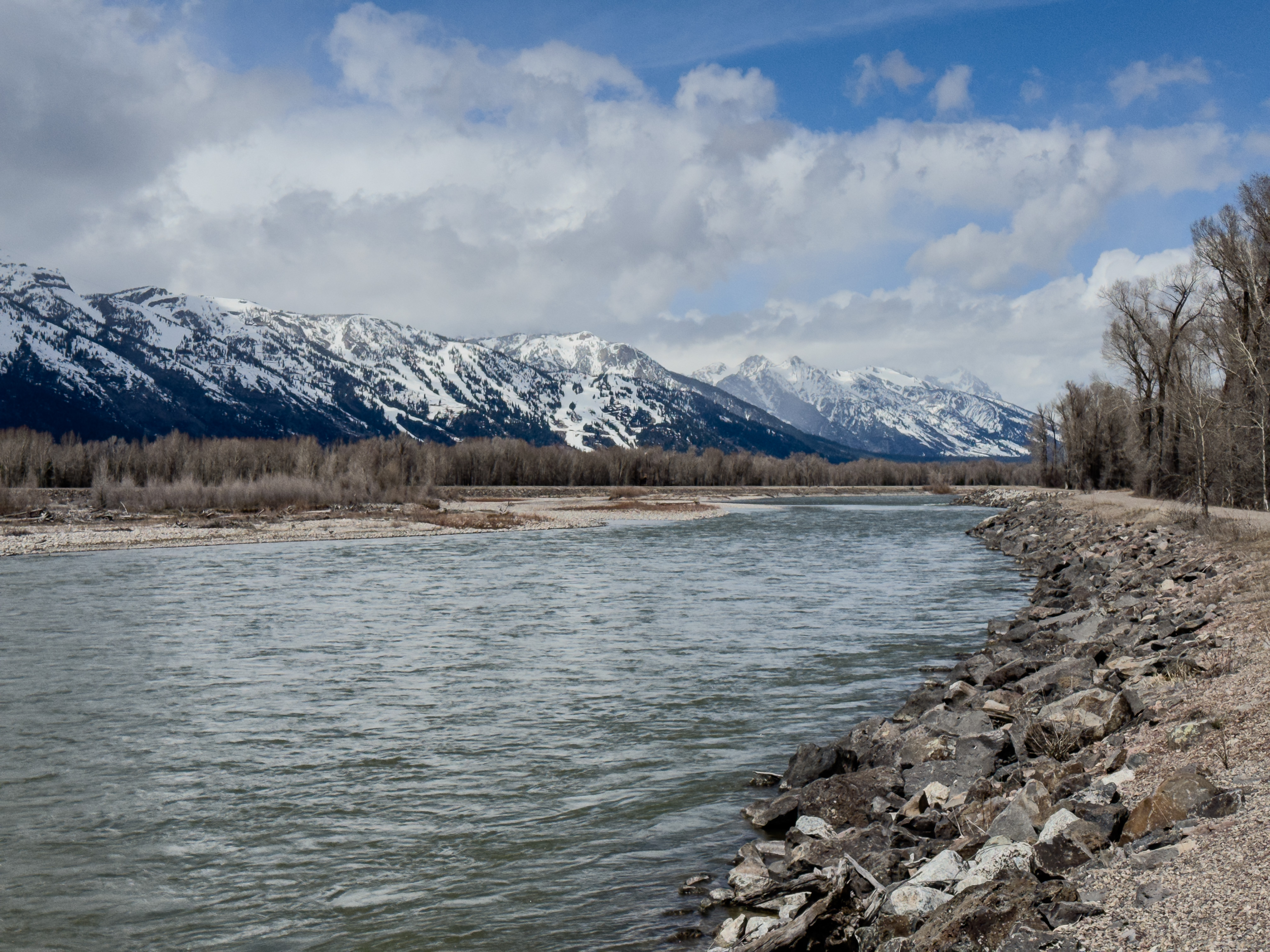
I used to think that visiting the same place more than once was boring, but after several visits to these two national parks and several other natural areas, my perspective has changed.
I now realize that you don’t begin to know a place until you have been there many times, and with that in mind, I am looking forward to seeing these parks again soon, and I think I will re-read Ranger Orville “Butch” Bach’s memoir, since good books and good places both merit more than one visit.
- Here is a link to maps of roads around the Greater Yellowstone ↩
- The book Fire Weather, by John Vaillant gives an excellent explanation of why the wildfire season starts so early in northern Alberta. ↩
- The current road was hurriedly paved in 2022 following a flood that wiped out the old road through Gardiner Canyon. ↩
- Tracking the Spirit of Yellowstone, and Reflections from Yellowstone and Beyond. ↩
- This article on a presentation by Orville Bach gives a sense of his warm character. ↩
- https://en.wikipedia.org/wiki/Lamar_River ↩
- “History and Dynamics of Glaciation in the Northern Yellowstone National Park Area”, Kenneth L. Pierce ↩
- Roadside Geology of Yellowstone Country, William J. Fritz, Robert C. Thomas, p. 141. ↩
- “Glaciers”, National Park Service https://www.nps.gov/yell/learn/nature/glaciers.htm ↩
- Yellowstone’s Birds: Diversity and Abundance in the World’s First National Park, edited by Douglas W. Smith, Lauren E. Walker, Katharine E. Duffy, p. 107-8. ↩
- For compelling social and economic studies of Jackson and the Greater Yellowstone area see Justin Farrell’s two books, The Battle for Yellowstone, and Billionaire Wilderness. ↩
- “The Two-Ocean Stream”, Eric Herman, WaterShapes https://watershapes.com/the-two-ocean-stream/ ↩
- At the time, I thought it was the famous grizzly 399, but I now think it was another bear, since 399 had only a single cub in 2018. ↩
- I highly recommend the recent PBS Nature documentary “Grizzly 399: Queen of the Tetons.” https://www.pbs.org/wnet/nature/filming-grizzly-399/30235/ ↩
One response to “Greater Yellowstone April 2024: Off-Season”
Thanks Tom. Beautiful photos and informative text
LikeLiked by 1 person